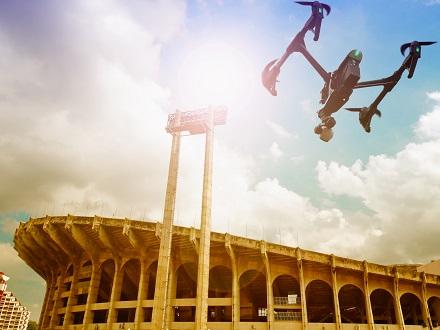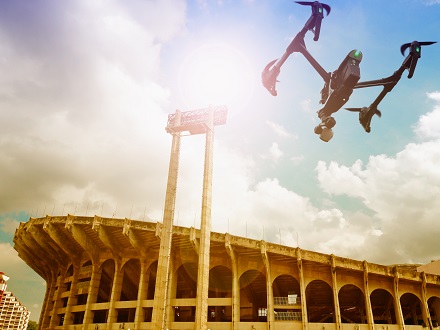

“Unmanned aerial vehicles, or drones, have halted four [MLB] games so far this season … by flying directly over ballparks during play,” reports Morning Consult. The incidents have only caused momentary delays and there haven’t been fans on site to worry about, but the string of drone intrusions raises red flags about the vulnerability of outdoor sports facilities to airborne security threats.”
Those incidents occurred in Minneapolis on Aug. 4, Boston on Aug. 13, New York on Sept. 2 and Los Angeles on Sept. 4, Morning Consult notes. In each case, umpires cleared the field until the drone left the area.
According to Morning Consult:
Many of the open-air facilities that house NFL and MLB teams now employ some sort of drone detection system, which is intended to identify potential threats through the use of technologies such as radio-frequency detection, RADAR and LIDAR. Current regulations put in place by the Federal Aviation Administration, however, do not allow security teams to respond by intercepting or disabling drones once they are determined to be a threat.
“Federal law prohibits public or private entities such as Major League Baseball from intercepting or disrupting unmanned aircraft system (UAS) operations,” the FAA said in a statement, adding that it “encourages Major League Baseball to work with federal, state, local and tribal territory law enforcement when concerned about unauthorized UAS operations above stadiums.”
So, even though the FAA restricts drones from flying within three nautical miles of a sports facility on game days, it would still be illegal for stadium security to knock an encroaching drone out of the sky. Only the Department of Homeland Security and the Justice Department are authorized to take down threatening drones, under the FAA Reauthorization Act of 2018.
… Sports properties’ primary recourse under the current rules is to locate the drone pilot and ask them to stop operating the aircraft in restricted airspace or provide their location to local law enforcement. Drones manufactured by China-based DJI, or Shenzhen DJI Sciences and Technologies Ltd., which account for about 75 percent of those sold in the United States, are equipped with technology that transmits the pilot’s location and other pertinent information like model information, flight status and paths to detection systems on the ground.
“Finding the pilot during the flight provides the safest and most straightforward way to deal with this kind of scenario and typically, in the stories we’ve heard about these kinds of incidents, the pilot is right there in the parking lot or down the street,” said Brendan Schulman, vice president of policy and legal affairs for DJI.
Typically, drones over stadiums do not prove to be a security threat, according to Kyle Hopkins, vice president of customer development at Dallas-based 911 Security. “Most of the time, especially in sports entertainment, it’s not somebody trying to cause nefarious actions. It’s not somebody with bad intent,” he told Morning Consult. “It usually, in our experience, has been somebody that wants to get a cool photo or wants to get a cool video, or whatever the case was, and they weren’t aware of the laws and the repercussions if they flew into that environment.”
The irony involving baseball’s battle against drones is that authorized drones have emerged as a potential tool in disinfecting and sanitizing indoor and outdoor sports venues in the COVID-19 era by employing a modified crop-duster approach. A handful of U.S. companies pitched their products to stadiums, arenas, amphitheaters and other mass-gathering facilities. In spring, when testing was underway at such venues as Principal Park in Des Moines Iowa (home of the Triple A Pacific Coast League’s Iowa Cubs) and Sahlen Field in Buffalo, N.Y., (where the Buffalo Bisons of the Triple-A International League play). Another cottage industry has sprung up, this one devoted to making cardboard spectators that can be placed around the stadium to approximate a crowd.
Another challenge brought on by the coronavirus is fallout from stadiums piping in fake crowd noise. NFL stadium officials are allowed to crank up the volume to 70 decibels — no more and no less. (By comparison, the average volume at a sold-out NFL game is estimated to be in the mid-90-decibel range, according to The Hearing Review, and Kansas City Chiefs fans hold the record for the loudest outdoor stadium at 142.2 decibels.)
The NFL is monitoring noise levels and sent a detailed, two-page memoto all team presidents, general managers, head coaches, public relations directors, marketing directors, stadium managers, game presentation managers and game day designees regarding “game presentation audio policies.”
Pro football’s fake crowd noise, which come from multichannel surround audio recordings compiled from every stadium and provided by NFL Films, did not appear to be a hit with coaches, players or fans. After the New England Patriots defeated the Miami Dolphins in Week 1 in an empty Gillette Stadium, Patriots head coach Bill Belichick gave a one-word answer to a reporter who asked: “What was the atmosphere like in the stadium with fans there? Can you compare it to anything else you’ve experienced in your football career?”
Belichick’s dry response? “Practice.”
Kyle Shanahan, head coach of the San Francisco 49ers, might not even be that generous. After his team conducted practices at Levi’s Stadium with crowd noise piped in, he compared it to “human torture” on local radio stationKNBR. “That’s what I’ve struggled with the most,” he said. “When there’s constant noise, no high or low, there might as well be no noise.”
Even TV announcers Greg Gumbel and Rich Gannon weighed in during the Week 1 matchup between the Las Vegas Raiders and the Carolina Panthers at Bank of America Stadium in Charlotte, N.C. As The Charlotte Observerreported, “Gumbel and Gannon noted several times that the crowd noise piped into Sunday’s game was a little off. Short rushes got big cheers or the cheer came too early or too late — too often.”
Fans watching Week 1 games on TV took to Twitter to make their own noise from the comfort of their couches. “It obviously isn’t reactive to the game so it just sounds like they’re playing at a very loud cocktail party,”tweeted @reckless. @nickfromstorrs compared the fake crowd noise to“a loop of ‘stop them on third down’”and called it “annoyingly distracting.” And @Sneetches3316 begged the NFL to drop the noise, because he’d “rather listen to the sounds of the game!”
If the league continues with the canned noise, NFL players might prefer the volume turned up. New Orleans Saints quarterback Drew Brees likened the 70-decibel limit in the Mercedes-Benz Superdome, where the Saints beat the Tampa Bay Buccaneers in Week 1, to a whisper, according to USA Today. Brees’ teammate, tight end Jared Cook, called fan noise in an empty stadium “eerie.”
“I was kind of disappointed,” added Tampa Bay coach Bruce Arians. “I don’t think it was fair to the Saints to have it that low, because you can have an easy conversation across the field to somebody,” Arians said. “It’s not a very good deal. It should be fixed.”
College football teams have a little more leeway when it comes to piping crowd noise into empty stadiums. Iowa State, for example, has teamed with HearMeCheer — an app that, according to SportTechie.com, “aggregates noise from viewers at home to be used inside venues and on broadcasts.” The Cyclone reportedly are the first college program to partner with the Toronto-based startup.
At Iowa State’s home opener against Louisiana-Lafayette on Sept. 12, “fans at home were able to open the HearMeCheer app, which collects sounds from the microphones of a user’s smartphone, tablet or computer,” SportsTechie.com reports. “The app’s algorithms convert the collected fan noises into one audio stream that’s played inside Jack Trice Stadium." And that's not all. Major League Baseball is currently testing a similar app, meaning, one article states, "Red Sox fans will be able to boo the Yankees all season long."
HearMeCheer, which was tested over the summer in Taiwan’s Chinese Professional Baseball League, also inked a deal in August with Major League Soccer’s New York Red Bulls.
College stadiums in which a limited number of fans are allowed appear to be making the live experience as fun for fans as possible. For Miami’s season opener at Hard Rock on Sept. 10, just 13,000 tickets were made available and face masks were required on all fans over the age of 2 except when eating or drinking. “The jumbotron featured a ‘Social Distance Cam’ that showed fans sitting in distanced clusters while The Police song ‘Don’t Stand So Close to Me’ blared over the loudspeakers,” reported the Miami Herald.
For some coaches, fake crowd noise (regardless of the source) only amplified what’s missing at college football game this season.
“Even with the noise over the loudspeaker, you look up and there’s just nothing,” North Carolina head coach Mack Brown told local mediafollowing the Tar Heels’ season-opening win at home over Syracuse. “We’re playing without the traditions. It’s still football. It’s still against somebody else. You still want to win and it’s very competitive, but you … don’t have fans cheering when you come in and out. You don’t have students. You don’t have the band. So all of the pageantry we have is just gone right now. And we have to understand that, and it’s the only way we can play.”

